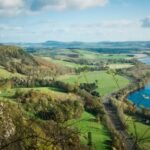Scientists in Scotland have devised a groundbreaking method to analyze the intensity and heat of wildfires stretching back millions of years. This new technique could provide critical insights into fire behavior amid worsening climate conditions.
Unlocking Fire Histories with Advanced Charcoal Analysis
A team of geoscientists from the University of Aberdeen, in collaboration with fire engineers from the University of Edinburgh, has pioneered a technique to measure wildfire energy release by analyzing charcoal remains. Their research, published in Scientific Reports, introduces a novel approach using Raman spectroscopy to assess fire intensity in both historical and contemporary settings.
The significance of this breakthrough lies in its ability to reconstruct wildfires dating back as far as 420 million years. By analyzing ancient plant remnants preserved in rock, researchers can now better understand the role of fire in shaping ecosystems over time. This development comes at a crucial time, as climate change exacerbates the frequency and severity of modern wildfires.

Wildfires and Climate Change: A Growing Threat
The impact of wildfires has never been more pressing. Last month, wildfires in California devastated communities, destroying or damaging over 18,000 homes and structures. The scale and intensity of these fires have been on the rise, with fire seasons becoming longer and individual blazes more destructive.
According to the Forest Fires 2023 report, these patterns “underscore the undeniable effects of climate change.” Wetland ecosystems, crucial for carbon storage, are particularly vulnerable. So-called “zombie fires” burning deep in peatland can release 100 times more carbon than surface wildfires, making them a critical factor in global emissions.
How the New Method Works
To develop this analytical tool, scientists conducted controlled fire experiments at the University of Edinburgh’s Rushbrook Fire Laboratory. They used high-powered lasers to analyze charcoals produced under varying conditions, simulating the complexities of real wildfire events.
Dr. Thomas Theurer, research fellow at the University of Aberdeen, highlighted the significance of the findings. “By studying simultaneous changes in ancient plant communities, climate, and fire, we can uncover the drivers of intense fire activity and how ecosystems responded,” he explained.
A key advantage of this method is its non-destructive nature. Unlike traditional geothermometry, which estimates fire temperatures through chemical changes in charcoal, this approach quantifies energy release, providing a more comprehensive understanding of wildfire behavior.
Comparing Ancient and Modern Fire Behavior
One of the major challenges in wildfire research is distinguishing natural fire patterns from those influenced by human activities such as deforestation, agriculture, and fire suppression.
This new technique circumvents that challenge by allowing researchers to examine past fire activity independent of human interference. By doing so, it provides an invaluable reference point for comparing historical and modern wildfire behavior.
Professor Rory Hadden, Personal Chair of Fire Science at the University of Edinburgh, emphasized the broader implications: “This allows us to assess and contextualize predictions of future fire activity, giving us crucial insights into how wildfires may shape global ecosystems and human populations in the years to come.”
Potential Applications Beyond Wildfire Research
Beyond studying natural wildfires, this technique has potential applications in archaeology, forensic fire investigations, and fire safety science. Because charcoal is a common by-product of combustion, researchers believe it could be used to analyze historical fires in human settlements or even crime scenes involving arson.
This interdisciplinary potential underscores the far-reaching impact of the Scottish team’s work. With wildfires intensifying globally, the ability to measure fire energy across timeframes could prove invaluable in shaping both scientific understanding and future fire management strategies.


















